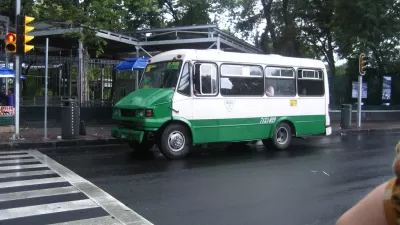Uber-style public transit gets people in urban and rural communities where they need to go in ways fixed-route buses can’t. But do the numbers pencil out?

On-demand, point-to-point ride programs in Missouri cities are receiving mixed reviews, reports Meg Cunningham of the Kansas City Beacon. This type of publicly funded service, also known as microtransit, has been touted as an alternative to fixed bus routes in Kansas City and St. Louis and a way to improve mobility in smaller cities and towns without public transportation.
Microtransit was initially launched in Missouri in response to declining bus ridership, exacerbated by the pandemic. Transit agencies cut routes and frequency, which resulted in even fewer riders. But people still need to get where they’re going, and within their budgets.
Funded by a combination of tax dollars and grants, public microtransit services hire private drivers in a similar fashion to ride-share services like Uber and Lyft. The original vision was to extend the reach of public transportation—for example, by connecting suburban riders to the nearest bus line—or providing affordable rides in service zones without frequent bus service.
While demand for microtransit is high and increasing, some locales are finding it’s not as cost-effective or efficient as a fixed-route bus system, Cunningham reports. “Kansas City’s microtransit program, IRIS, launched in March. On average, it costs the city about $29 a trip. Kansas City is seeing much of its demand for microtransit come from those traveling into the city from the Northland or Martin City. For the KCATA system as a whole, the cost per passenger in October was $1.88.”
As Missouri’s microtransit experiment continues, officials and advocates are still hopeful it can become a cost-effective way to meet a growing need, particularly in rural areas.
“Missouri has to think creatively about how to connect rural and urban communities,” Tyler Means, the chief mobility and strategy officer at the KCATA, told the Kansas City Beacon. Rural communities “are going to shrink and age, and they’re going to need more services in areas that have just kind of been forgotten about,” he said. “So they need solutions like this to allow them to gain access to the resources they need.”
FULL STORY: Missouri cities and rural towns look at Uber-style rides to replace buses. But can they?

Alabama: Trump Terminates Settlements for Black Communities Harmed By Raw Sewage
Trump deemed the landmark civil rights agreement “illegal DEI and environmental justice policy.”

Planetizen Federal Action Tracker
A weekly monitor of how Trump’s orders and actions are impacting planners and planning in America.

Why Should We Subsidize Public Transportation?
Many public transit agencies face financial stress due to rising costs, declining fare revenue, and declining subsidies. Transit advocates must provide a strong business case for increasing public transit funding.

Understanding Road Diets
An explainer from Momentum highlights the advantages of reducing vehicle lanes in favor of more bike, transit, and pedestrian infrastructure.

New California Law Regulates Warehouse Pollution
A new law tightens building and emissions regulations for large distribution warehouses to mitigate air pollution and traffic in surrounding communities.

Phoenix Announces Opening Date for Light Rail Extension
The South Central extension will connect South Phoenix to downtown and other major hubs starting on June 7.
Urban Design for Planners 1: Software Tools
This six-course series explores essential urban design concepts using open source software and equips planners with the tools they need to participate fully in the urban design process.
Planning for Universal Design
Learn the tools for implementing Universal Design in planning regulations.
Caltrans
Smith Gee Studio
Institute for Housing and Urban Development Studies (IHS)
City of Grandview
Harvard GSD Executive Education
Toledo-Lucas County Plan Commissions
Salt Lake City
NYU Wagner Graduate School of Public Service





























